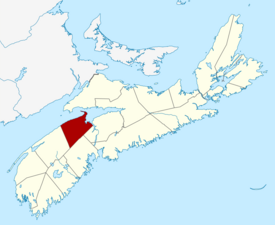Kings County, Nova Scotia
| Kings County | ||
|---|---|---|
| County | ||
|
||
| Nickname(s): Land of Orchards, Vineyards & Tides | ||
 Location of Kings County, Nova Scotia |
||
| Coordinates: 45°00′N 64°36′W / 45.0°N 64.6°WCoordinates: 45°00′N 64°36′W / 45.0°N 64.6°W | ||
| Country |
|
|
| Province |
|
|
| Towns | Berwick / Kentville / Wolfville | |
| Established | August 17, 1759 | |
| Incorporated | April 17, 1879 | |
| Electoral Districts Federal |
Kings—Hants / West Nova |
|
| Provincial | Kings North / Kings South / Kings West | |
| Government | ||
| • Type | Kings County Municipal Council | |
| • Mayor-Elect | Peter Muttart | |
| Area | ||
| • Land | 2,126.71 km2 (821.13 sq mi) | |
| Population (2016) | ||
| • Total | 60,600 | |
| • Density | 28.5/km2 (74/sq mi) | |
| • Change 2011-16 |
|
|
| Time zone | AST (UTC-4) | |
| • Summer (DST) | ADT (UTC-3) | |
| Area code(s) | 902 | |
| Dwellings | 29,187 | |
| Median Income* | $44,744 CDN | |
| Website | www.county.kings.ns.ca | |
|
||
Kings County is a county in the Canadian province of Nova Scotia. It is in central Nova Scotia on the shore of the Bay of Fundy, with its northeastern part forming the western shore of the Minas Basin.
The first inhabitants of the coast, valley and interior of Kings County were the Mi'kmaq. Archaeological evidence from sites in the area indicate Mi'kmaq habitation dates back thousands of years. The Mi'kmaq were a semi-nomadic people who followed seasonal food sources. Their lives changed with the arrival of the Europeans.
The colonization of "Les Mines" and Grand Pre began in the 1680s when a few families relocated from the French settlement at Port Royal. These "Acadian" settlers were named after the French name for the land "Acadie" meaning "land of plenty". These farmers were accustomed to farming on dyked lands, and did so here as well. This took place on the normally salty but fertile marshes that were found on the banks of the Minas Basin, through the use of dykes and aboiteaux that allowed fresh water to enter but kept out the salt-water tide. The Acadian farmers prospered in Kings County, and lived harmoniously with the Mi'kmaq. The Acadians and Mi'kmaq jointly fought numerous battles against the British in the Raid on Grand Pre, Battle of Grand Pre, and the Siege of Grand Pre.
After defeat and expelling the Acadians, British control of the land was secured by repopulating the former French lands with settlers from New England. Between 1760 and 1768 some 8000 New England Planters arrived in Nova Scotia, the largest number settling in Kings County in three agricultural townships: Horton, Cornwallis, and Aylesford. The Planters revived and expanded the Acadian dykeland agriculture through projects such as the Wellington Dyke and cleared more upland fields, gradually moving west from the initial settlements along the Minas Basin Rivers. The legacy of the New England Planters is still a tangible part of the life in Kings County, and had an important influence on Nova Scotian ideas on democratic government, freedom of religion and equality of education.
...
Wikipedia

